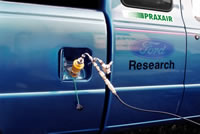
Power plants generate electrical power by using fuels like coal, oil or natural gas. A simple power plant consists of a boiler, turbine, condenser and a pump. Fuel, burned in the boiler and superheater, heats the water to generate steam. The steam is then heated to a superheated state in the superheater. This steam is used to rotate the turbine which powers the generator. Electrical energy is generated when the generator windings rotate in a strong magnetic field. After the steam leaves the turbine it is cooled to its liquid state in the condenser. The liquid is pressurized by the pump prior to going back to the boiler A simple power plant is described by a Rankine Cycle.
RANKINE CYCLE
Saturated or superheated steam enters the turbine at state 1, where it expands isentropically to the exit pressure at state 2. The steam is then condensed at constant pressure and temperature to a saturated liquid, state 3. The heat removed from the steam in the condenser is typically transferred to the cooling water. The saturated liquid then flows through the pump which increases the pressure to the boiler pressure (state 4), where
 the water is first heated to the saturation temperature, boiled and typically superheated to state 1. Then the whole cycle is repeated.
the water is first heated to the saturation temperature, boiled and typically superheated to state 1. Then the whole cycle is repeated.Typical Modifications
 REHEAT
REHEATWhen steam leaves the turbine, it is typically wet. The presense of water causes erosion of the turbine blades. To prevent this, steam is extracted from high pressure turbine (state 2), and then it is reheated in the boiler (state 2') and sent back to the low pressure turbine.
REGENERATION
Regeneration helps improve the Rankine cycle efficiency by preheating the feedwater into the boiler. Regeneration can be achieved by open feedwater heaters or closed feedwater heaters. In open feedwater heaters, a fraction of the steam exiting a high pressure turbine is mixed with the feedwater at the same pressure. In closed system, the steam bled from the turbine is not directly mixed with the feedwater, and therefore, the two streams can be at different pressures
Combined Cycle Plants

Fossil fuel-fired (central) power plants use either steam or combustion turbines to provide the mechanical power to electrical generators. Pressurized high temperature steam or gas expands through various stages of a turbine, transferring energy to the rotating turbine blades. The turbine is mechanically coupled to a generator, which produces electricity.
Steam Turbine Power Plants:
Steam turbine power plants operate on a Rankine cycle. The steam is created by a boiler, where pure water passes through a series of tubes to capture heat from the firebox and then boils under high pressure to become superheated steam. The heat in the firebox is normally provided by burning fossil fuel (e.g. coal, fuel oil or natural gas). However, the heat can also be provided by biomass, solar energy or nuclear fuel. The superheated steam leaving the boiler then enters the steam turbine throttle, where it powers the turbine and connected generator to make electricity. After the steam expands through the turbine, it exits the back end of the turbine, where it is cooled and condensed back to water in the surface condenser. This condensate is then returned to the boiler through high-pressure feedpumps for reuse. Heat from the condensing steam is normally rejected from the condenser to a body of water, such as a river or cooling tower.
Steam turbine plants generally have a history of achieving up to 95% availability and can operate for more than a year between shutdowns for maintenance and inspections. Their unplanned or forced outage rates are typically less than 2% or less than one week per year.
Modern large steam turbine plants (over 500 MW) have efficiencies approaching 40-45%. These plants have installed costs between $800 and$2000/kW, depending on environmental permitting requirements.
